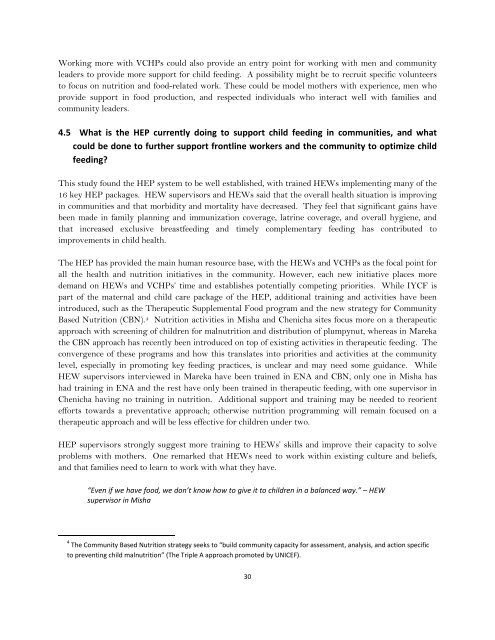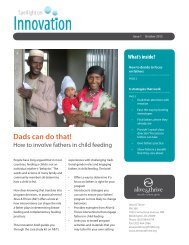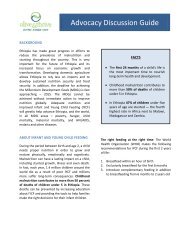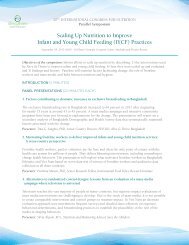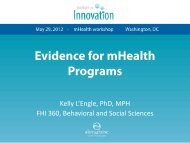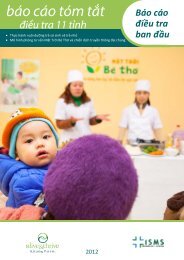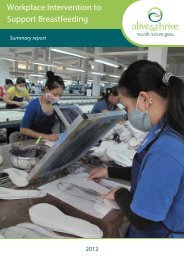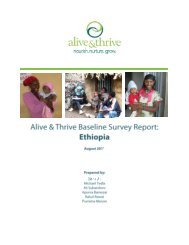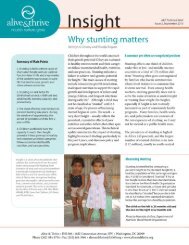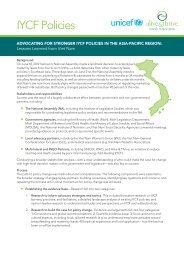IYCF Practices, Beliefs, and Influences in SNNP ... - Alive & Thrive
IYCF Practices, Beliefs, and Influences in SNNP ... - Alive & Thrive
IYCF Practices, Beliefs, and Influences in SNNP ... - Alive & Thrive
You also want an ePaper? Increase the reach of your titles
YUMPU automatically turns print PDFs into web optimized ePapers that Google loves.
Work<strong>in</strong>g more with VCHPs could also provide an entry po<strong>in</strong>t for work<strong>in</strong>g with men <strong>and</strong> communityleaders to provide more support for child feed<strong>in</strong>g. A possibility might be to recruit specific volunteersto focus on nutrition <strong>and</strong> food-related work. These could be model mothers with experience, men whoprovide support <strong>in</strong> food production, <strong>and</strong> respected <strong>in</strong>dividuals who <strong>in</strong>teract well with families <strong>and</strong>community leaders.4.5 What is the HEP currently do<strong>in</strong>g to support child feed<strong>in</strong>g <strong>in</strong> communities, <strong>and</strong> whatcould be done to further support frontl<strong>in</strong>e workers <strong>and</strong> the community to optimize childfeed<strong>in</strong>g?This study found the HEP system to be well established, with tra<strong>in</strong>ed HEWs implement<strong>in</strong>g many of the16 key HEP packages. HEW supervisors <strong>and</strong> HEWs said that the overall health situation is improv<strong>in</strong>g<strong>in</strong> communities <strong>and</strong> that morbidity <strong>and</strong> mortality have decreased. They feel that significant ga<strong>in</strong>s havebeen made <strong>in</strong> family plann<strong>in</strong>g <strong>and</strong> immunization coverage, latr<strong>in</strong>e coverage, <strong>and</strong> overall hygiene, <strong>and</strong>that <strong>in</strong>creased exclusive breastfeed<strong>in</strong>g <strong>and</strong> timely complementary feed<strong>in</strong>g has contributed toimprovements <strong>in</strong> child health.The HEP has provided the ma<strong>in</strong> human resource base, with the HEWs <strong>and</strong> VCHPs as the focal po<strong>in</strong>t forall the health <strong>and</strong> nutrition <strong>in</strong>itiatives <strong>in</strong> the community. However, each new <strong>in</strong>itiative places moredem<strong>and</strong> on HEWs <strong>and</strong> VCHPs’ time <strong>and</strong> establishes potentially compet<strong>in</strong>g priorities. While <strong>IYCF</strong> ispart of the maternal <strong>and</strong> child care package of the HEP, additional tra<strong>in</strong><strong>in</strong>g <strong>and</strong> activities have been<strong>in</strong>troduced, such as the Therapeutic Supplemental Food program <strong>and</strong> the new strategy for CommunityBased Nutrition (CBN). 4 Nutrition activities <strong>in</strong> Misha <strong>and</strong> Chenicha sites focus more on a therapeuticapproach with screen<strong>in</strong>g of children for malnutrition <strong>and</strong> distribution of plumpynut, whereas <strong>in</strong> Marekathe CBN approach has recently been <strong>in</strong>troduced on top of exist<strong>in</strong>g activities <strong>in</strong> therapeutic feed<strong>in</strong>g. Theconvergence of these programs <strong>and</strong> how this translates <strong>in</strong>to priorities <strong>and</strong> activities at the communitylevel, especially <strong>in</strong> promot<strong>in</strong>g key feed<strong>in</strong>g practices, is unclear <strong>and</strong> may need some guidance. WhileHEW supervisors <strong>in</strong>terviewed <strong>in</strong> Mareka have been tra<strong>in</strong>ed <strong>in</strong> ENA <strong>and</strong> CBN, only one <strong>in</strong> Misha hashad tra<strong>in</strong><strong>in</strong>g <strong>in</strong> ENA <strong>and</strong> the rest have only been tra<strong>in</strong>ed <strong>in</strong> therapeutic feed<strong>in</strong>g, with one supervisor <strong>in</strong>Chenicha hav<strong>in</strong>g no tra<strong>in</strong><strong>in</strong>g <strong>in</strong> nutrition. Additional support <strong>and</strong> tra<strong>in</strong><strong>in</strong>g may be needed to reorientefforts towards a preventative approach; otherwise nutrition programm<strong>in</strong>g will rema<strong>in</strong> focused on atherapeutic approach <strong>and</strong> will be less effective for children under two.HEP supervisors strongly suggest more tra<strong>in</strong><strong>in</strong>g to HEWs’ skills <strong>and</strong> improve their capacity to solveproblems with mothers. One remarked that HEWs need to work with<strong>in</strong> exist<strong>in</strong>g culture <strong>and</strong> beliefs,<strong>and</strong> that families need to learn to work with what they have.“Even if we have food, we don’t know how to give it to children <strong>in</strong> a balanced way.” – HEWsupervisor <strong>in</strong> Misha4 The Community Based Nutrition strategy seeks to “build community capacity for assessment, analysis, <strong>and</strong> action specificto prevent<strong>in</strong>g child malnutrition” (The Triple A approach promoted by UNICEF).30


